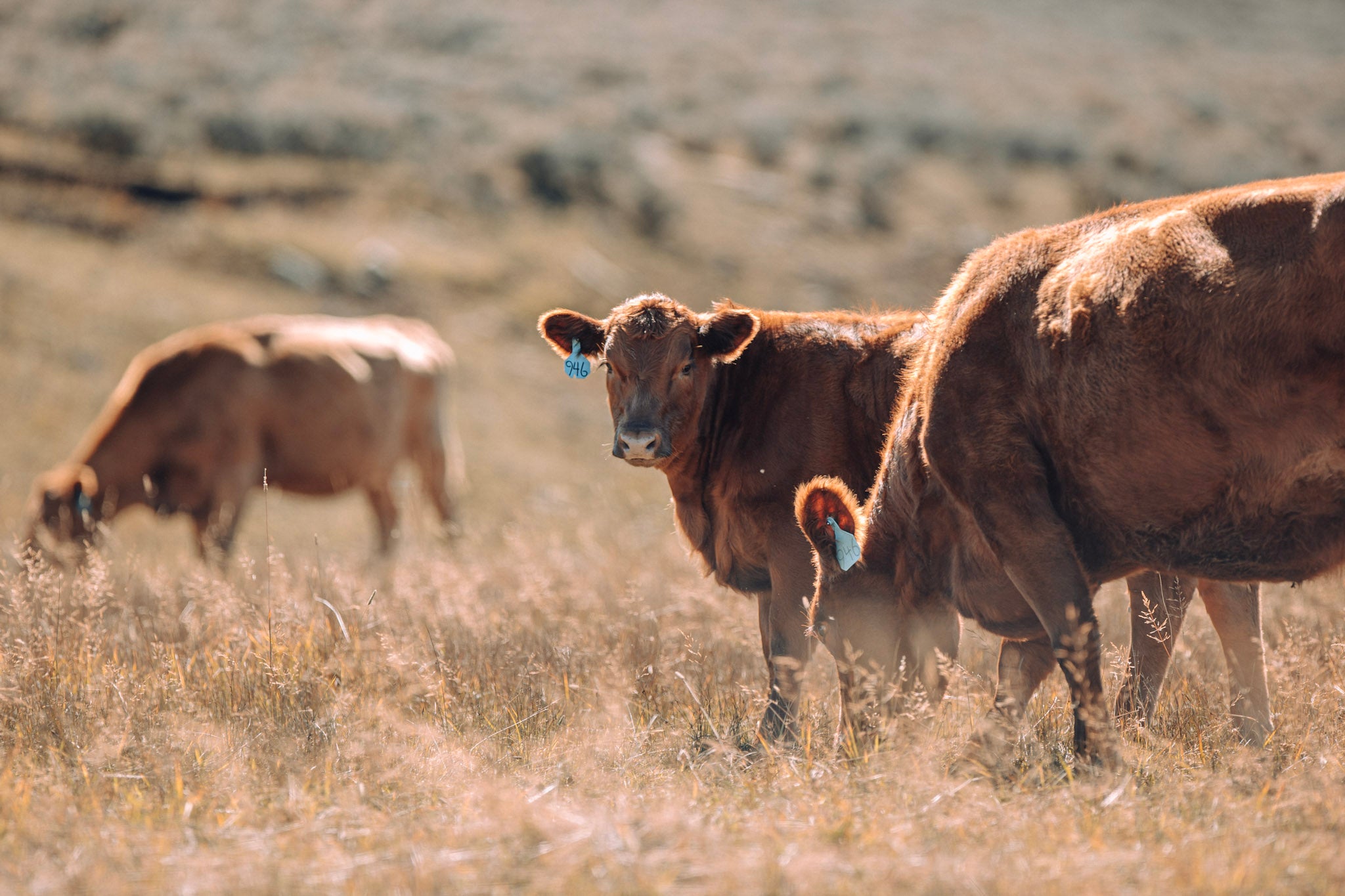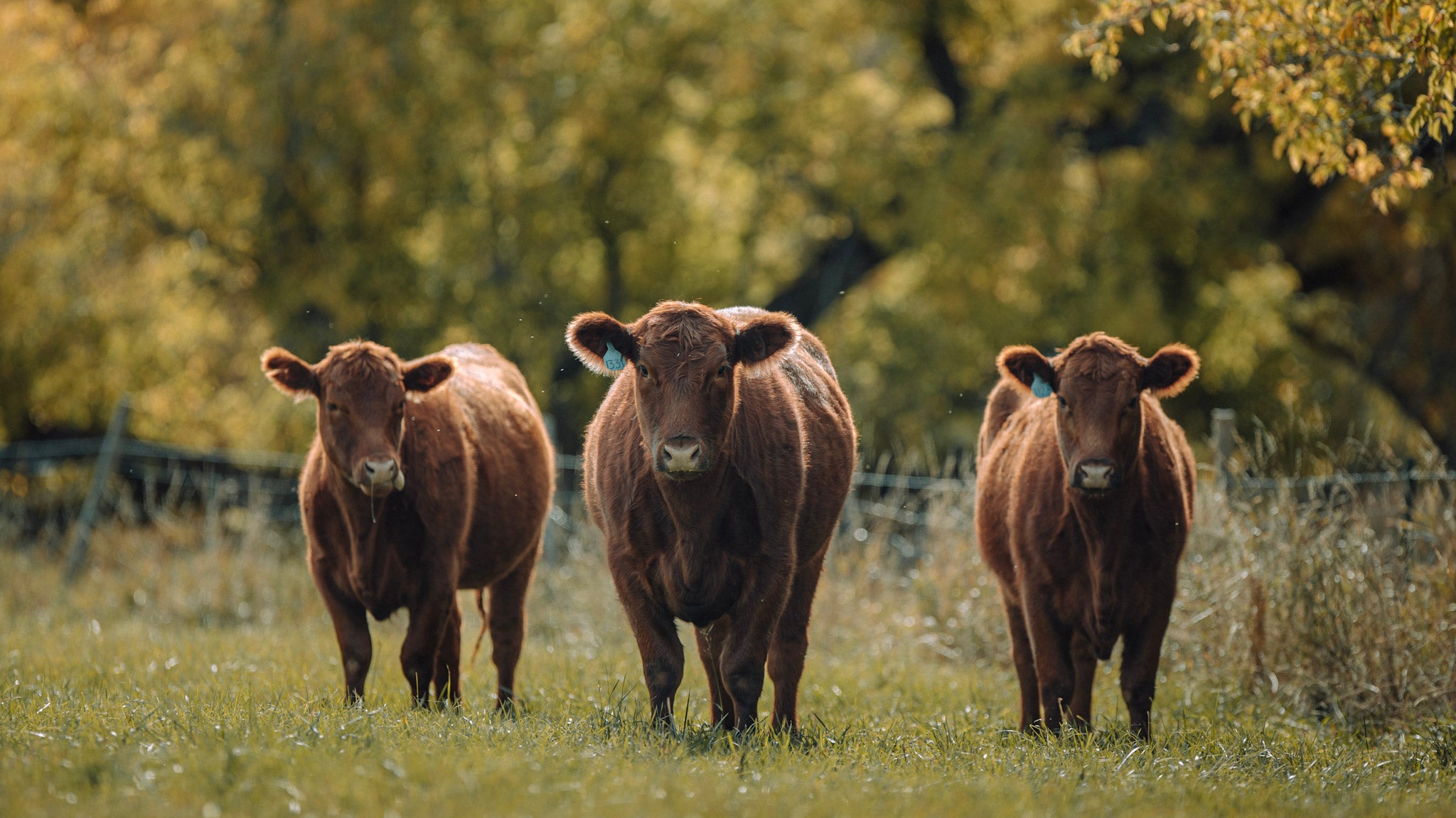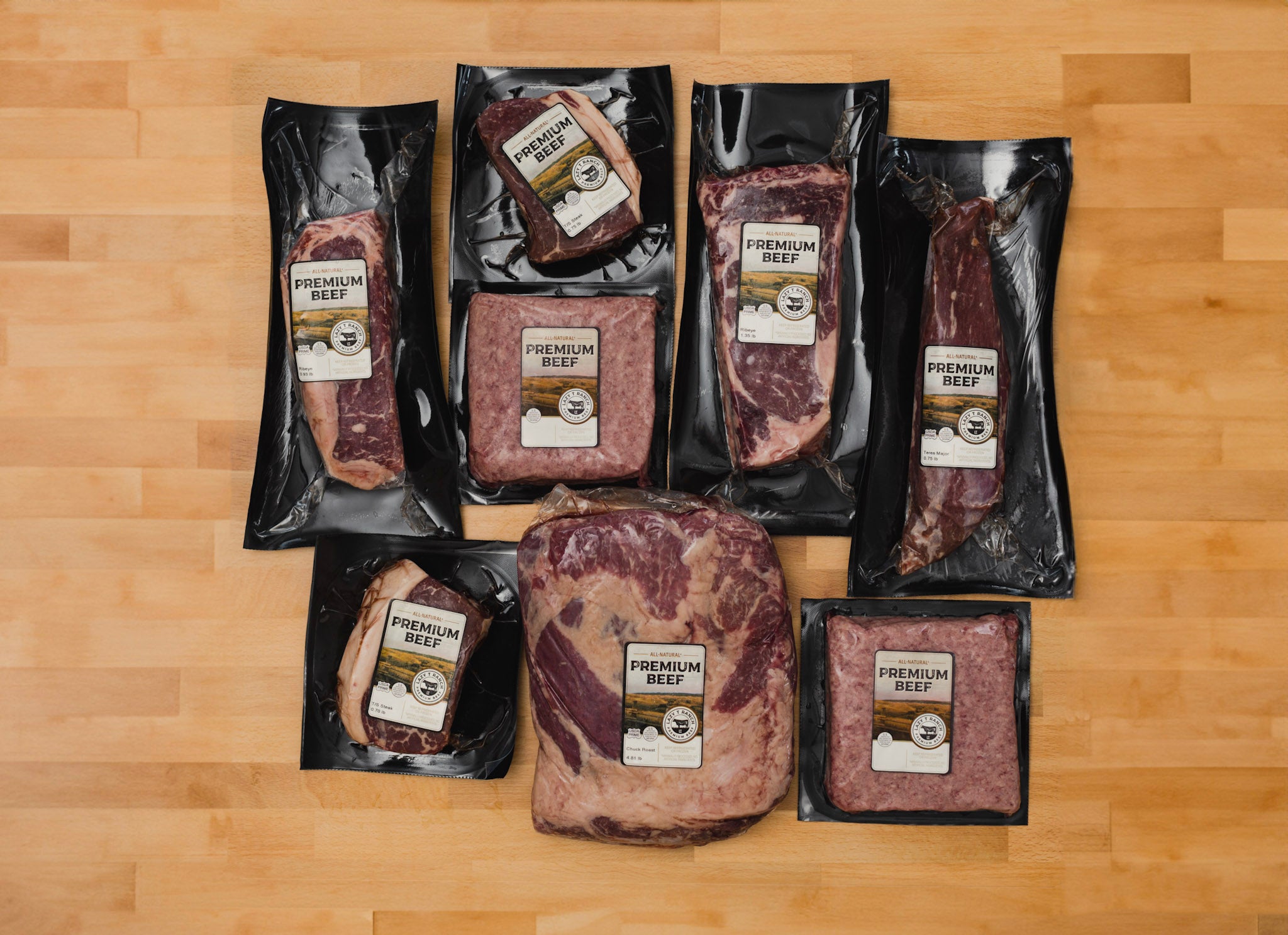
The Role of Genetics in Beef Quality: Selecting the Best Cattle
Hearing the word genetics may whisk you back to a high school biology class, but don’t let your eyes glaze over. Although the topic is complex, its effect on beef quality is straightforward. At least, the general principle is easy to understand.
This article is designed to teach you about genetics in relation to beef quality . . . and not at a Ph.D. level. (Lazy T’s writer scoured plenty of medical and scholarly journals to gather information, then rewrote that information in a way that shouldn’t numb your brain.)
Not only does genetics influence things like beef marbling, tenderness, and flavor, but it also has an impact on cattle’s growth efficiency, reproduction, and overall well-being.
Here at Lazy T Ranch, we harness the power of genetics to develop a healthy herd and produce delicious beef. It’s a process that requires years of patience, careful breeding, and—let’s face it—our cowboys artificially inseminating in a squeeze chute.
Before you can grasp the connection between genetics and beef quality, you need a crash course on cattle genetics and its associated terms.
Everything you need to know about cattle genetics:
Add phenotype and genotype to your vocabulary. Phenotype means “the observed performance of an animal in the field.” This can include continuous traits like milk yield and growth rate and discrete traits like susceptibility to disease. Genotype refers to strains of animals and genetic variants. Don’t worry. We’ll focus mainly on phenotypes in this article.
You should also know the term Expected Progeny Differences (EPDs). Think of EPDs as a judging system. They allow producers to compare animals within a breed for their genetic potential as parents for a given trait. Basically, if a beef producer wants a calf with a certain quality, they’d select parents either with that quality or with the genetic propensity.
EPDs offer a broad range of information, everything from pedigree, the animal’s own record, and progeny details. The more information about the animal, the more accurate the EPD. Producers must record traits (weaning weight, yearling weight, etc.) within a certain age window to meet EPD calculation requirements. This ensures a fair comparison of the animals.
Overall, EPDs represent the genetic component of the animal’s phenotype that is expected to be passed on to the next generation.
Although nongenetic factors such as nutritional programs and calving dates play a role in cattle health and beef quality, correct genetic selection yields significant results. The process of choosing sires and enhancing a herd’s genetics involves many equations and science.
We’ll save that for another day.
Beef producers take specific EPD traits into account when making genetic decisions.
- Calving ease direct – This refers to the percentage of unassisted births from first-calf heifers. Not only do calving difficulties add excessive labor to an already busy operation, but calf losses result in a direct loss of revenue. The more easily a heifer can give birth, the better!
- Birth weight - Although calving ease is its own EPD, birth weight affects a heifer’s ability to independently deliver a calf. Beef producers usually opt for sires (bulls) that are at or less than the breed average for birth weight. Small, healthy calves—that’s the goal.
- Weaning weight direct – Abbreviated as WW or WWD, weaning weight direct refers to the calf’s weight on the date it is weaned, typically around 200 days of age. The calf should weigh about 50% of its mother’s body weight, between 500 and 700 pounds. WWs help producers evaluate the growth potential of calves and estimate beef yield.
- Yearling weight – This calf measurement is taken between 320 and 410 days of age. It combines pre-weaning and post-weaning growth.
- Yearling height – Self-explanatory. The calf’s age and height (measured at the hip) are used to calculate the frame score. Yearling height predicts the animal’s mature body size.
- Milk – This EPD doesn’t measure how much milk a heifer or cow produces but rather the calf’s weaning weight due to the milk’s nutrients.
- Total maternal (maternal weaning weight) – Considering a female’s combined genetics for growth and milk, this EPD predicts the effects of her mothering ability on the weaning weight of her calves.
- Gestation length – The duration of the animal’s pregnancy.
- Calving ease maternal – Unlike direct, which focuses on the genetic probability of unassisted births when a sire is bred to first-calf heifers, calving ease maternal revolves around selecting for future daughters (heifers) that calve without assistance. To break it down further, calving ease direct is about the calf’s genetics in relation to ease of birth while calving ease maternal looks ahead to the future and a female’s ability to deliver her young.
- Mature height – An animal’s height at maturity, i.e., adulthood.
- Mature weight – An animal’s weight at maturity, i.e., adulthood.
- Scrotal circumference – This EPD indicates the age of maturity of a bull’s daughters. If a bull has a large scrotal circumference, his daughters should reach puberty earlier.
- Heifer pregnancy – The genetic likelihood a heifer will become pregnant.
- Stayability – A measure of reproductive longevity.
- Days to finish – This EPD predicts how many days cattle will spend on feed to reach a constant fat endpoint. The fewer the days, the more efficient the cattle.
- Average daily gain – A genetic prediction of how much weight per day calves will gain post-weaning.
- Maintenance energy – This EPD indicates how much quality forage per month will be needed for maintenance due to mature size and milking ability.
- Docility – A behavior-focused EPD. This information allows producers to breed for calves with docile temperaments, measured by how the animals enter, are restrained in, and exit the chute.
Now to look at EPDs that closely affect beef quality . . .
- Carcass weight – Refers to the weight of the animal after slaughter. Considering this EPD allows a producer to raise cattle that yield more beef.
- Percent retail product – A genetic prediction of how many trimmed, boneless retail cuts will come from the round, loin, rib, and chuck.
- Marbling – This EPD focuses on marbling score. The higher the score, the higher the quality of the beef.
- Ribeye area – Looking at genetic history, this EPD predicts the size of calves’ ribeye areas.
- Fat thickness – This EPD predicts a calf’s fatness when measured at the 12th rib.
- Tenderness – Warner Bratzler Shear Force (WBSF) measures the tenderness of beef and reports it in the pounds of force needed to cut through a 1-inch-thick piece of meat.
Other EPDs exist, such as Back Fat (BF), Yield Grade (YG), and Shear Force (SHR). If you’d like to learn more about EPDs, click here.
Complicated science aside, the use of EPDs boils down to a simple idea: If you breed animals with positive traits, their offspring will also have positive, if not better, traits. Understanding genetics (how it affects everything from general health and reproduction to beef quality) equips producers to make informed decisions about the breeding and development of their herds.
Why is marbling important and how is it influenced by genetics?
Ever look at a steak and notice flakes of buttery fat distributed throughout the beef? That is marbling, and it’s what gives meat flavor, juiciness, and a smooth texture. (Nobody likes chewy globs of fat.) A beef’s marbling determines its grade and price point. The higher the marbling score, the nicer the piece of meat.
Obviously, beef producers want cattle that yield marbled beef. Considering the marbling EPD when selecting bulls and breeding heifers/cows increases the likelihood that the offspring will have a higher marbling score. Yep, weight gain is affected by genetics!
How does genetics impact the tenderness of beef?
Like with marbling, beef’s tenderness is linked to its genetic history. The main takeaway of this article is that nearly everything about cattle is influenced by genetics—growth, efficiency, reproduction, and beef quality. Genetics even contribute to disease resistance in cattle.
Why are reproductive traits crucial in beef production and how are they influenced by genetics?
Two words. Money. Time. Beef producers rely on their cattle to recoup the development and maintenance costs. They need to turn a profit. Typically, cattle don’t become profitable until year 6. If a cow misses a calf, it doesn’t become profitable until year 7 or 8 depending on calf prices. Miss again, and the cow doesn’t recoup expenses until year 11. So, from a financial standpoint, it’s important for cattle to easily breed and produce healthy offspring.
Along with fertility EPDs, convenience traits such as structural soundness, udder quality, and calving ease are needed for the health and well-being of cattle. The animals must have good feet and leg structure to graze and breed. If they struggle to get around, they won’t eat and drink enough, which will impact their growth, and they’re less likely to reproduce.
Labor must be considered as well. Beef producers have limited time and resources. Heifers that do not calve easily (or have poorly structured udders) require assistance, which means additional work, which means additional costs. And if cattle suffer from bad feet and other ailments, they require hoof trimming and interventions. This again means significant added labor.
By breeding for desirable traits, beef producers can increase profitability and efficiency.
What is crossbreeding, and how can it improve beef quality?
Crossbreeding is a system of mating that involves combining the desirable characteristics of two or more breeds, thus achieving a higher overall performance level among crossbred animals. A fancy way of saying . . . take the best traits of two breeds and put them into one.
The results can either be called breed complementarity (when the strengths of one breed complement or mask the weaknesses of the other) or heterosis, a phenomenon that causes crossbred individuals to have an increased level of performance for certain traits over the average performance of their parents.
Not only does crossbreeding give beef producers the opportunity to increase the production of beef per cow, but it also allows them to breed for quality beef.
Cattle breeds differ when it comes to their intramuscular fat composition and types of meat fibers. Late maturing breeds such as Belgian Blue and Limousine are known for their muscle tone and less fat while early maturing breeds like Angus are famous for their marbling. The breed can also influence the lipid metabolism and dietary fatty acid content in bovine muscles.
Crossbred cattle can produce quality beef with the best traits of parent breeds. They can also have increased fertility, longevity, and health. A win-win for beef producers and consumers!
How is Lazy T Ranch leveraging genetics to ensure premium beef quality for its consumers?
We’ve spent years intentionally breeding our cattle to develop a healthy, efficient herd that yields marbled, premium beef. Our herd mainly consists of Angus crossbred with Hereford. To experience a taste of our ranch, explore our beef box offerings.


